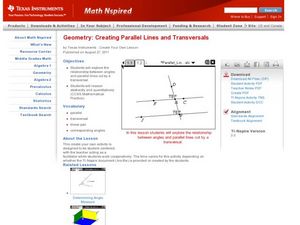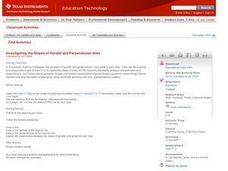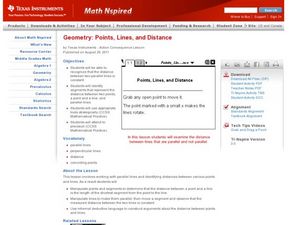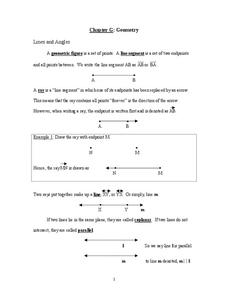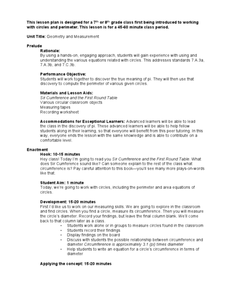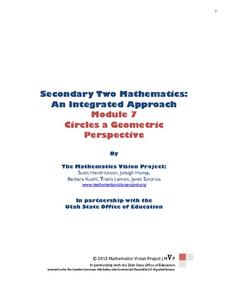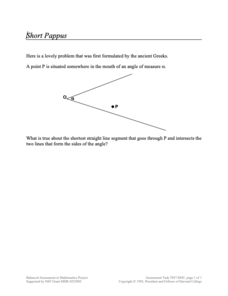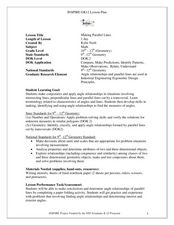Curated OER
Using Slope Angles
In this geometry worksheet, 10th graders use right triangle trigonometry to solve problems involving angle of elevation or depression. The one page worksheet contains eleven problems. Answers are not provided.
Curated OER
Quiz: Angles in Circles - Angles Outside the Circle
In this angles in circles worksheet, students explore angles outside a circle. Using given trigonometric ratios, they find the missing angle measurement or the length of a line. This one-page worksheet contains ten problems.
Curated OER
Geometry
In this geometry review game worksheet, students use the provided game cards and calling cards to play a Bingo-like game. Students learn geometric terms while playing a group game.
Curated OER
Intersecting Lines and Vertical Angles
Pupils identify and define intersecting lines and vertical angles. They draw two intersecting lines and measure one pair of vertical angles. Learners will also move a line to change the angles of a figure and describe the changes in the...
Curated OER
Creating Parallel Lines and Transversals
Have your class create parallel lines. Students will learn how to identify the different angles created by a parallel line cut by a transversal. Then, they identify and name similar and different angles.
Curated OER
Circles and Angles
Students identify tangents, chords and secants. In this geometry lesson, students graph circles and identify angles created by secant lines, tangent lines and chords.
Curated OER
Investigating the Slopes of Parallel and Perpendicular Lines
High schoolers investigate parallel and perpendicular lines. They use Cabri Jr. to construct and explore the relationships between the slopes of parallel and perpendicular lines. The drawing and measurement tools available with Cabri Jr....
Texas Instruments
Copying an Angle
High schoolers will investigate geometric construction in this geometry lesson. Your pupils can explore the basic construction of copying an angle, using the constructions tools of Cabri Jr.
Curated OER
Investigating Equations of Lines
High schoolers investigate linear equations as they use technology (Cabri, Jr.) to explore the equations of lines in slope-intercept form. The technology allows learners to manipulate the line and observe the changes in the parameters of...
Curated OER
Points, Lines, and Distance
Students calculate the distance between two points. In this geometry lesson, students define the meaning of the distance between parallel lines. They find the point of intersection of other lines.
Curated OER
Measuring Angles
Sixth graders identify and measure right, acute, obtuse, and straight angles. In this geometry lesson plan, 6th graders review the definition of each angle and are shown examples of each specific angle. Students use toothpicks, gumdrops,...
Curated OER
Altitude, Median, and Angle Bisector of a Triangle
Learners investigate the special properties of an altitude, a median, and an angle bisector and explore how these special segments divide the area of a triangle. The dynamic nature of Cabri Jr. allows pupils to form and verify conjectures.
Curated OER
Geometry
In this line and angles worksheet, students explore basic geometry vocabulary. They classify polygons. Students determine the area and perimeter of given shapes. They examine the parts of a circle, find volume and...
Curated OER
Geometry and Measurement
Middle schoolers view a right triangle displayed by the teacher. Students measure legs and the interior angles of the triangle. They look for a pattern or relationship between the legs and angles. Middle schoolers use pegboards and...
Curated OER
Lines and Angles
Sixth graders explore lines and angles. They create visual representations of lines, rays and angles by drawing them on paper and using a geoboard. On paper, 6th graders write a summary of the characteristics of their representations.
Curated OER
Proofs Chapter 2: Geometry
In this geometry activity, students look at given pictures and prove congruent lines and angles. This three-page activity contains nine multi-step problems.
Curated OER
Chapter 4.5 Geometry Practice Problems
In this geometry practice problems worksheet, students write geometric proofs to prove the validity of given circumstances. Students prove parallel lines, perpendicular lines, and similar angles. This four-page worksheet contains eight...
Mathematics Vision Project
Circles: A Geometric Perspective
Circles are the foundation of many geometric concepts and extensions - a point that is thoroughly driven home in this extensive unit. Fundamental properties of circles are investigated (including sector area, angle measure, and...
K12 Reader
Basic Geometry Terms
Set your pupils up to start on geometry by teaching them some introductory terminology. Pupils learn the terms by reading a short passage and looking at examples. They then respond to five questions related to the text.
Concord Consortium
Short Pappus
It's all Greek to me. Scholars work a task that Greeks first formulated for an ancient math challenge. Provided with an angle and a point inside the angle, scholars develop conjectures about what is true about the shortest line segment...
CK-12 Foundation
Bisectors of Line Segments and Angles: Cut a Line
Geometric constructions build relationships —by simply manipulating simple tools. An interactive lesson presents a completed construction of a segment bisector and has learners analyze the important aspects. Ultimately, they should be...
EngageNY
Fundamental Theorem of Similarity (FTS)
How do dilated line segments relate? Lead the class in an activity to determine the relationship between line segments and their dilated images. In the fourth section in a unit of 16, pupils discover the dilated line...
Curated OER
Angles ~ Right Angles
Have your class review how to identify right angles. Learners identify right angles, and then write the number of angles found in each shape.
Curated OER
Making Parallel Lines
Students differentiate between parallel and perpendicular lines. In this geometry lesson, students make conjectures and apply it to solve real life situations. They collect data and make predictions based on the data.






